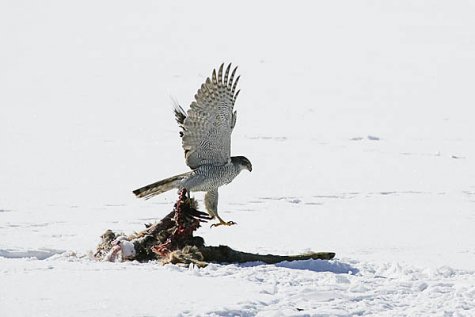Ill-famed: the goshawk
Photo: Arne Ader
Translation: Liis
Goshawk on deer cadaver
| Goshawk |
Kanakull
|
Nothing to be done about it - one has to live somehow. Its size is comparable to a raven. In flight the light-coloured or cream underparts with the dark cross bars show, and the long tail with four broad dark bands. In flight the tail is kept narrowly together, when changing direction it is spread out like a fan. The wings are broad and rounded. The colour of the plumage is the same all year. Eyes are yellow, the beak black, the base of the beak as well as the feet yellow. The female birds are about one fourth larger than the males.
Our goshawks are generally sedentary, in addition migrants arrive from east and north, so meeting them is more likely in winter. The menu consists of rodents - water voles and voles; passerines, pigeons, corvids, the Galliformes birds - capercaillie, hazel grouse, partridges; the larger female goshawk can manage a rabbit. When available carrion is eaten too.
Goshawks haven’t done so well during the last few years. Around the turn of the millenium there were still about 600 nesting pairs, the estimate now is only 300 pairs, and progeny is meagre.
As comparison there are up to six thousand nesting pairs of our most numerous Falconiformes raptor, the buzzard,.
About the sparrowhawk:









